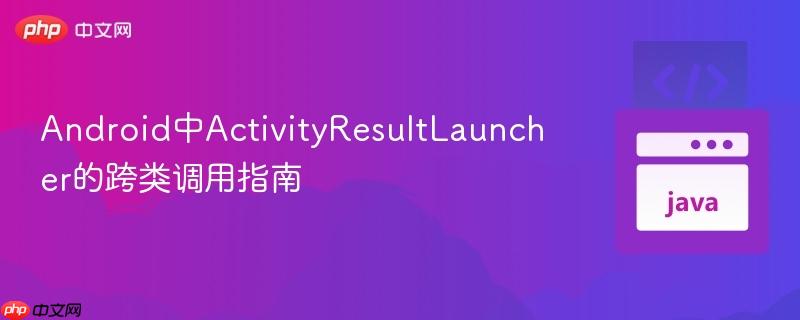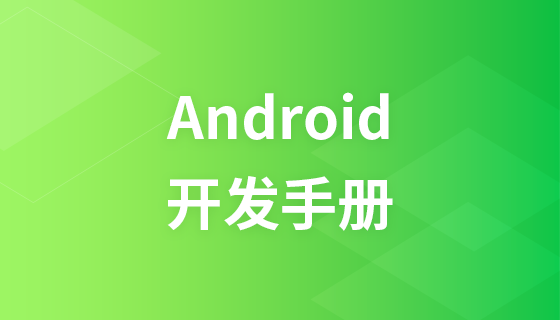
本文详细介绍了在android应用中如何注册`activityresultlauncher`,并重点阐述了将其实例安全地传递给其他类进行跨模块调用的两种主要策略:通过构造函数传递和通过方法参数传递。文章通过示例代码演示了这些实现方式,并提供了关于生命周期管理和潜在内存泄漏等关键注意事项,旨在帮助开发者构建更模块化、可维护的android应用。
在现代Android开发中,ActivityResultLauncher 提供了一种简洁、类型安全的方式来启动活动并处理其结果,取代了传统的 startActivityForResult() 和 onActivityResult() 方法。通常,ActivityResultLauncher 实例在 Activity 或 Fragment 的生命周期方法(如 onCreate())中注册。然而,在实际项目中,我们可能需要在其他辅助类、业务逻辑类或Presenter中触发活动启动,并接收其结果。本文将详细介绍如何实现 ActivityResultLauncher 的跨类调用。
首先,我们需要在 Activity 或 Fragment 中注册 ActivityResultLauncher。这个过程通常在宿主组件的 onCreate() 或 onAttach() 方法中完成,以确保其与组件的生命周期绑定。
import androidx.activity.result.ActivityResult;
import androidx.activity.result.ActivityResultCallback;
import androidx.activity.result.ActivityResultLauncher;
import androidx.activity.result.contract.ActivityResultContracts;
import androidx.appcompat.app.AppCompatActivity;
import android.app.Activity;
import android.content.Intent;
import android.net.Uri;
import android.os.Bundle;
import android.widget.Button;
import android.widget.Toast;
public class MainActivity extends AppCompatActivity {
private ActivityResultLauncher<Intent> activityResultLauncher;
private String selectedPath; // 用于存储选择的路径
@Override
protected void onCreate(Bundle savedInstanceState) {
super.onCreate(savedInstanceState);
setContentView(R.layout.activity_main);
// 注册 ActivityResultLauncher
activityResultLauncher = registerForActivityResult(
new ActivityResultContracts.StartActivityForResult(),
new ActivityResultCallback<ActivityResult>() {
@Override
public void onActivityResult(ActivityResult result) {
if (result.getResultCode() == Activity.RESULT_OK) {
if (result.getData() != null) {
// 处理返回的数据,例如获取文件路径
Uri uri = result.getData().getData();
if (uri != null) {
// 示例:处理特定URI类型,如content://com.android.providers.media.documents/document/image%3A12345
// 实际路径解析可能需要更复杂的逻辑,取决于URI类型
selectedPath = uri.toString(); // 简化处理,实际可能需要更复杂的路径解析
Toast.makeText(MainActivity.this, "Selected URI: " + selectedPath, Toast.LENGTH_LONG).show();
}
}
} else {
Toast.makeText(MainActivity.this, "Activity cancelled or failed", Toast.LENGTH_SHORT).show();
}
}
});
Button openFileButton = findViewById(R.id.open_file_button);
openFileButton.setOnClickListener(v -> {
// 在MainActivity中直接启动
Intent intent = new Intent(Intent.ACTION_GET_CONTENT);
intent.setType("*/*"); // 选择任意类型文件
intent.addCategory(Intent.CATEGORY_OPENABLE);
activityResultLauncher.launch(intent);
});
}
}在上述代码中,activityResultLauncher 被注册用于启动一个活动并获取其结果。接下来,我们将探讨如何在其他类中利用这个已注册的 activityResultLauncher 实例。
要在其他类中执行 activityResultLauncher.launch(...) 操作,核心思想是将已注册的 ActivityResultLauncher 实例传递给这些类。以下是两种常用的策略:
这种方法适用于需要长期持有 ActivityResultLauncher 实例的辅助类或业务逻辑类。在创建这些类的实例时,将 ActivityResultLauncher 作为参数传入。
示例代码:
首先,定义一个辅助类 FilePickerHelper:
import android.content.Intent;
import android.widget.Toast;
import androidx.activity.result.ActivityResultLauncher;
public class FilePickerHelper {
private final ActivityResultLauncher<Intent> launcher;
// 构造函数接收 ActivityResultLauncher 实例
public FilePickerHelper(ActivityResultLauncher<Intent> launcher) {
this.launcher = launcher;
}
// 在辅助类中定义方法来启动文件选择器
public void openFilePicker() {
if (launcher != null) {
Intent intent = new Intent(Intent.ACTION_GET_CONTENT);
intent.setType("*/*");
intent.addCategory(Intent.CATEGORY_OPENABLE);
launcher.launch(intent);
} else {
// 可以在此处添加错误处理或日志
System.err.println("ActivityResultLauncher is not initialized.");
}
}
// 辅助方法,用于在需要时清理引用,防止内存泄漏(可选,取决于生命周期管理)
public void releaseLauncher() {
// 如果FilePickerHelper的生命周期比Activity长,可以考虑在此处清理引用
// 但通常情况下,由于launcher是final,并且Activity/Fragment会自行管理其生命周期,
// 这种显式清理不是强制的,除非有特定的内存管理需求。
}
}然后在 MainActivity 中使用 FilePickerHelper:
// ... 在 MainActivity 的 onCreate 方法中 ...
private FilePickerHelper filePickerHelper;
@Override
protected void onCreate(Bundle savedInstanceState) {
super.onCreate(savedInstanceState);
setContentView(R.layout.activity_main);
// ... 注册 activityResultLauncher ...
// 实例化 FilePickerHelper,并传入 activityResultLauncher
filePickerHelper = new FilePickerHelper(activityResultLauncher);
Button openFileButtonFromHelper = findViewById(R.id.open_file_button_from_helper);
openFileButtonFromHelper.setOnClickListener(v -> {
// 通过辅助类启动文件选择器
filePickerHelper.openFilePicker();
});
}如果辅助类或工具类只需要临时使用 ActivityResultLauncher,或者其方法是静态的,那么可以通过方法参数的方式传递 ActivityResultLauncher 实例。
示例代码:
定义一个工具类 ActivityLauncherUtil:
import android.content.Intent;
import androidx.activity.result.ActivityResultLauncher;
public class ActivityLauncherUtil {
// 静态方法,接收 ActivityResultLauncher 作为参数
public static void launchFilePicker(ActivityResultLauncher<Intent> launcher) {
if (launcher != null) {
Intent intent = new Intent(Intent.ACTION_GET_CONTENT);
intent.setType("*/*");
intent.addCategory(Intent.CATEGORY_OPENABLE);
launcher.launch(intent);
} else {
System.err.println("ActivityResultLauncher is null, cannot launch.");
}
}
// 非静态方法也可以,同样接收 ActivityResultLauncher 作为参数
public void launchCustomActivity(ActivityResultLauncher<Intent> launcher, Intent customIntent) {
if (launcher != null && customIntent != null) {
launcher.launch(customIntent);
} else {
System.err.println("ActivityResultLauncher or Intent is null, cannot launch.");
}
}
}然后在 MainActivity 中使用 ActivityLauncherUtil:
// ... 在 MainActivity 的 onCreate 方法中 ...
@Override
protected void onCreate(Bundle savedInstanceState) {
super.onCreate(savedInstanceState);
setContentView(R.layout.activity_main);
// ... 注册 activityResultLauncher ...
Button openFileButtonFromUtil = findViewById(R.id.open_file_button_from_util);
openFileButtonFromUtil.setOnClickListener(v -> {
// 通过工具类的静态方法启动文件选择器
ActivityLauncherUtil.launchFilePicker(activityResultLauncher);
});
Button launchCustomButton = findViewById(R.id.launch_custom_activity_button);
launchCustomButton.setOnClickListener(v -> {
// 通过工具类的非静态方法启动自定义活动
Intent customIntent = new Intent(MainActivity.this, AnotherActivity.class);
new ActivityLauncherUtil().launchCustomActivity(activityResultLauncher, customIntent);
});
}在实现 ActivityResultLauncher 的跨类调用时,需要注意以下几点:
通过将 ActivityResultLauncher 实例作为构造函数参数或方法参数传递,我们可以在Android应用中的其他类中灵活地触发活动启动和处理结果。这种方法有助于实现更清晰的模块化设计,将UI交互逻辑与业务逻辑分离。在实践中,务必注意生命周期管理和潜在的内存泄漏问题,以确保应用的稳定性和性能。
以上就是Android中ActivityResultLauncher的跨类调用指南的详细内容,更多请关注php中文网其它相关文章!

每个人都需要一台速度更快、更稳定的 PC。随着时间的推移,垃圾文件、旧注册表数据和不必要的后台进程会占用资源并降低性能。幸运的是,许多工具可以让 Windows 保持平稳运行。




Copyright 2014-2025 https://www.php.cn/ All Rights Reserved | php.cn | 湘ICP备2023035733号